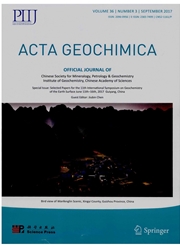

 中文摘要:
中文摘要:
在这糊 REE 集中和 Sr 和从 Furong 矿石的 Bailashui 锡矿床的荧石的 Nd 同位素组成回答的在场的作者,南部的湖南省。结果证明在荧石的 REE 的全部的数量通常是低的,从有在学习区域的 Qitianling 花岗石的类似于那些的使球粒状陨石正常化的 REE 分发模式的 0.705 ~ 8.785 μg/g ,与显著否定 Eu 异例由 LREE 丰富模式描绘了。荧石在范围以内在 Sr 同位素组成变化 0.7083 0.7091,价值比在这个区域的主人碳酸盐岩石的那些是比花岗石并且高的那些低的。ɛ 荧石的 Nd (t) 价值在 −9.4 和 +10.3 之间变化,两个都揭示那外壳 -- 并且披风来源材料涉及形成矿石的热水的液体。在这张矿床上与以前的研究结合了, Bailashui 锡矿床是速度集合并且仔细空间地在这个区域与花岗石的岩浆酌联系。热水的荧石是在热水的液体和海洋的碳酸盐摇的花岗石的 magmatic 之间的液体 / 岩石相互作用的产品。而在形成矿石的液体的 Sr 主要来自热水的液体和海洋的碳酸盐摇的花岗石的 magmatic,在形成矿石的液体的 REE 和 F 从花岗石被导出,尽管在 Sr 同位素组成的变化不能被这二结束成员的简单混合物解释。证据证明形成矿石的液体具有外壳披风的混合起源,但是液体可能是,这不完全地一致,这可以被不同来源的液体的不同类的混合引起。
 英文摘要:
英文摘要:
In this paper the authors present the REE concentrations and Sr and Nd isotopic compositions of fluorites from the Bailashui tin deposit of the Furong ore field, southern Hunan Province. The results showed that the total amount of REE in fluorites is usually low, ranging from 0.705 to 8.785 μg/g with the chondrite-normalized REE distribution patterns similar to those of the Qitianling granites in the study area, characterized by LREE-enrichment patterns with pronounced negative Eu anomalies. The fluorites vary in Sr isotopic composition within the range of 0.7083-0.7091, the values are lower than those of the granites and higher than those of the host carbonate rocks in this area. The εNd(t) values of fluorites vary between -9.4 and +10.3, revealing that both the crust- and mantle-source materials were involved in the ore-forming hydrothermal fluids. Combined with previous studies on this ore deposit, the Bailashui tin deposit is temporally and spatially closely related with granitic magmatism in this area. The hydrothermal fluorites are the product of fluid/rock interactions between granitic magmatic hydrothermal fluid and marine carbonate rocks. The REE and F in the ore-forming fluid were derived from the granites, whereas Sr in the ore-forming fluid came mainly from the granitic magmatic hydrothermal fluid and marine carbonate rocks, although variations in Sr isotopic composition cannot be explained by a simple mixture of these two end-members. Evidence demonstrated that the ore-forming fluids are of crustal-mantle mixing origin, but that the fluids were probably incompletely homogenized and this may be caused by inhomogeneous mixing of the fluids of different sources.
 同期刊论文项目
同期刊论文项目
 同项目期刊论文
同项目期刊论文
 A precise U-Pb age on cassiterite from the Xianghualing tin-polymetallic deposit ( Hunan , South Chi
A precise U-Pb age on cassiterite from the Xianghualing tin-polymetallic deposit ( Hunan , South Chi Characteristics of rare earth elements (REE), strontium and neodymium of hydrothermal fluorites from
Characteristics of rare earth elements (REE), strontium and neodymium of hydrothermal fluorites from 期刊信息
期刊信息
